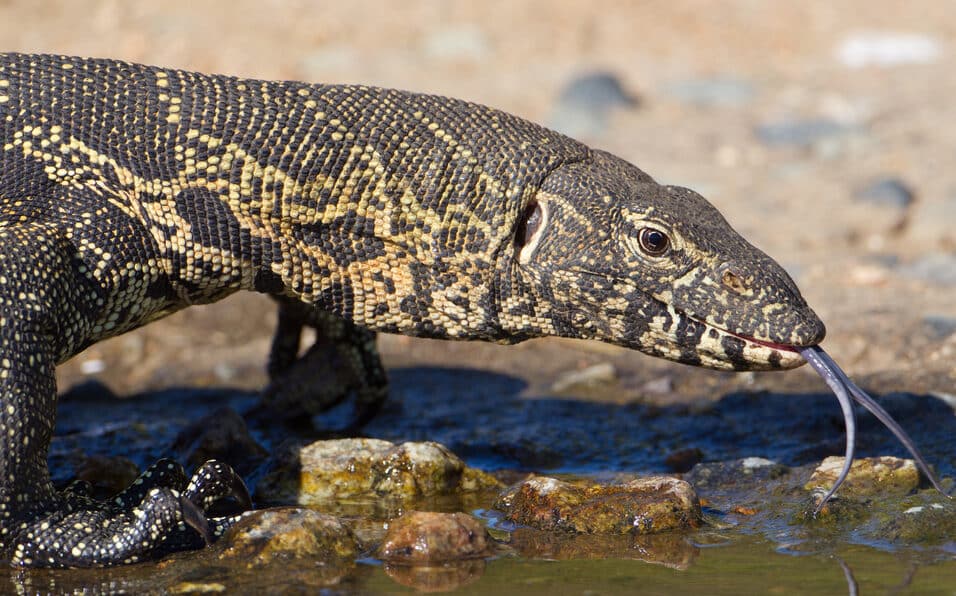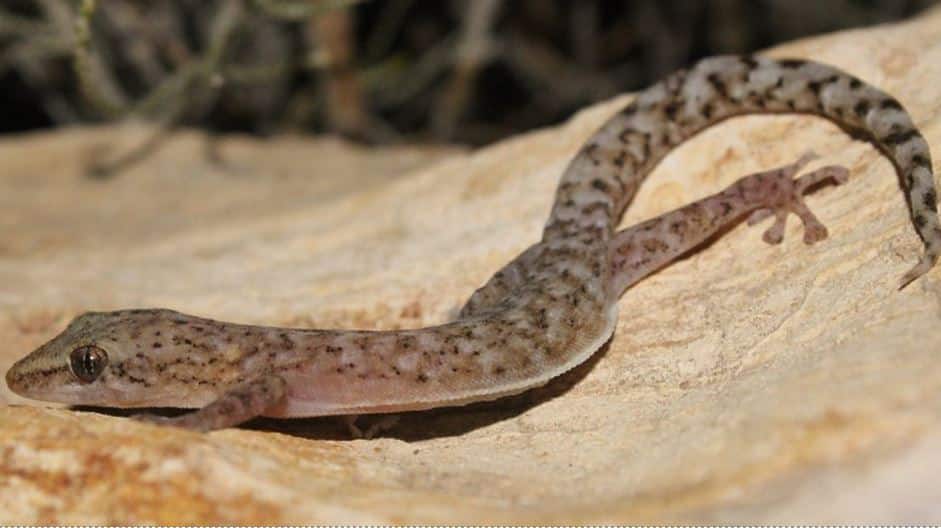12 Common LIZARDS found in South Africa! (ID GUIDE)
Do you want to learn about the different kinds of lizards in South Africa?

If so, you’ve come to the right place! In the article below, I have listed the lizards you can expect to see. For each species, you’ll find out how to identify that lizard correctly, along with pictures and interesting facts!
12 Lizards That Live IN South Africa:
#1. Tropical House Gecko
- Hemidactylus mabouia

How to identify:
- Length: 5 inches (12.7 cm).
- Lifespan: Between 3 and 5 years.
- Blackish-brown bands that can change color from grey to white and even dark brown.
The Tropical House Gecko is native to sub-Saharan Africa and prefers scrubby and sandy areas near the beach. But this small lizard feels at home in suburban areas in South Africa, where it is often found in homes. These geckos mainly feed on spiders, cockroaches, scorpions, moths, anoles, grasshoppers, and even other geckos.
Due to their adaptability, Tropical House Geckos are now found worldwide after being introduced by humans.
#2. Nile Monitor
- Varanus niloticus

How to identify:
- Length: Between 47 – 86 inches (119 to 218 cm).
- Lifespan: Between 10 and 20 Years.
- Nile Monitors have prominent skin patterns; both males and females are grey/brown on top and have green/yellow barring on their tails. Both sexes have large, greenish-yellow spots on their backs, and their underside and throats are creamy-yellow.
Nile Monitors are one of the largest and most spectacular lizards to observe in South Africa.
Look for them roaming near a permanent water source near woodlands, scrubs, evergreen thickets, mangroves, and swamps. Nile Monitors feed on frogs, toads, rodents, small turtles, birds, eggs, insects, and fish.
Luckily, the Nile Monitor is a lizard, not a human; otherwise, society would frown upon its polygamous behavior. Both males and females mate with several other partners.
After mating, the female takes a break from the males and makes a suitable nest in termite borrows or digs a hole near water where she lays up to 60 eggs. The female is patient during the incubation process, which lasts six to nine months. The baby monitors dig their way to freedom, or the female digs them out, and after three to four years, they are ready to mate themselves.
#3. Flap-necked Chameleon
- Chamaeleo dilepis

How to identify:
- Males and females have a coloring that ranges from brown to yellow to green. Both sexes have between 1 and 3 light patches on their upper flanks and a light stripe on their lower sides.
- It is identified by its broad tail that starts at the base and a spur that grows behind each hind foot.
The Flap-necked Chameleon is a large lizard belonging to the Chamaeleonidae family, a common sight in South Africa. These unique lizards prefer moist or arid savannah, coastal forests, bushy grass, and woodlands, but it is known to venture into suburban and rural areas. They feed on various insects and invertebrates, like beetles and grasshoppers.
When it is time for breeding, the Flap-necked Chameleon male is no stranger to showing off his strength and masculinity by fighting other males to secure a suitable female. Winning the fight does not necessarily persuade the female, but it at least allows the male to approach her.
If the male is accepted, courtship with the female is brief and only lasts a few minutes. Mating lasts about an hour and is done in the trees’ safety.
#4. African Striped Skink
- Trachylepis striata

How to identify:
- Length: Up to 9.8 inches (24.9 cm).
- Lifespan: 18 years.
- Bronze-brownish with two full-length yellow stripes along the spine.
The African Striped Skink is easily identified by the two yellowish stripes along its spine, which is why it’s called a “Striped Skink.”
Grasslands and forests are home to this shy lizard that prefers to burrow underground to avoid predators. Sometimes, hiding from predators isn’t enough, and the Striped Skink will shed its tail to escape, but it grows back within a few months.
It doesn’t take long for baby Striped Skinks to grow up. After the youngsters take their first breath, it only takes 15 to 18 months to mature and reproduce.
#5. Cape Dwarf Gecko
- Lygodactylus capensis
Also called the Common Dwarf Gecko

How to identify:
- They have a brown or grey stippled throat, cream belly, and greyish/brown back.
- Females are larger than the male.
One of the smallest lizards in South Africa (and the world) is the Cape Dwarf Gecko.
It only grows to a maximum length of 1.7 inches (4.3 cm), shorter than a matchbox.
Cape Dwarf Geckos prefer protective areas like woodlands, savannas, and forests, but they do not shy away from humans. They are often seen roaming the walls and gardens in towns and cities.
As expected, these small lizards mostly feed on small insects and invertebrates. They are extremely active and require a lot of feeding to support their energetic lifestyle, especially when breeding.
#6. Rainbow Skink
- Trachylepis margaritifera

How to identify:
- Normally dark brown or olive-brown. Sometimes, they have orange/yellow stripes that run down to their blue tail.
- Females and young males have yellowish/ orange lines and blue tails, while adult males have small white spots on their olive base.
The Rainbow Skink is known for its bright blue tail that shimmers when it basks in the sun. These lizards prefer high, elevated areas in South Africa.
They spend most of the day in mountain regions crawling through cracks and holes for their next meal. They have gotten used to humans and sometimes wander into suburban areas and houses.
#7. Variable Skink
- Trachylepis varia

How to identify:
- Blackish, pale brown, olive green, or red-brown back and sometimes has black spots. Look for a clear, white stripe down its backbone with a blueish-white belly.
- There is little difference between males and females except that females live longer.
The Variable Skink prefers dry savanna areas and grassland as their habitat in South Africa, where they spend their days climbing trees and rocks. They are great hunters and use barks, leaves, and stones to hide under, from which they pounce on their prey.
They waste no time reproducing because their life expectancy is less than two years. Once an individual is eight months old, they are ready to breed, and males set out to find a female.
#8. Southern Rock Agama
- Agama atra

How to identify:
- Colors range between brown and grey, but they all have a white belly.
- A pale stripe runs through the center of their tail.
- During the mating season, the adult male’s head turns blue.
South Africa is home to the Southern Rock Agama, an incredibly beautiful and lively lizard. They can be found in rocky landscapes and mountainous regions.
Males are territorial but seldom display aggression toward others and will avoid fighting if possible. But when the male has no choice but to fight, he shows dominance over other males by changing color, charging with his mouth open, and bobbing his head.
Males make females feel like royalty by repeatedly bowing their heads. After the female finds the male worthy, the pair copulate.
#9. Cape Dwarf Chameleon
- Bradypodion pumilum

How to identify:
- Green body with a rusty-red to orange lateral stripe that is often seen.
- Males and females look similar, but the male’s colors are brighter, and his head crest is bigger.
Cape Town, a coastal city in South Africa, is home to the Cape Dwarf Chameleon, and tropical forestry is the ideal environment for this medium-sized lizard. Beautiful river valleys with thick vegetation are where they are naturally found, although they do often wander into urban gardens.
Like other chameleons, their tongue is twice their body length and is the ideal prey-catching weapon. To hunt, the Cape Dwarf Chameleon settles on a branch and waits patiently for an insect or arthropod to get within striking distance. Then, it shoots out its tongue towards its prey.
These lizards are oviparous, which means that after mating, the eggs develop and hatch inside the female, and she births live young. When the birthing starts, the female positions herself on a branch and drops the baby straight to the ground! The sudden impact on the ground signals the youngster to find safety and indicates that it needs to survive on its own from that moment onwards.
#10. Marbled Leaf-toed Gecko
- Afrogecko porphyreus

How to identify:
- Typical grows to 2-5 in (5-13 cm) long.
- It has a brown body with patterns of stripes, spots, and bands.
- Females are slightly smaller and not as colorful as males.
The Marbled Leaf-toed Gecko is a VERY small lizard found in South Africa!
They are so small they are able to hide from predators in small cracks and underneath rocks and bark. They inhabit gardens, forests, houses, and just about anywhere they can find food.
The Marbled Leaf-toed Gecko is an exceptional hunter, consuming a large amount of food. In fact, they are a great form of pest control and are welcomed by many people into their yards. They have specialized toe pads covered with microscopic bristles called setae and scales that enhance their climbing ability.
They are peaceful lizards and show no aggression toward others in the same species; males often share the same territory.
#11. Cape Skink
- Trachylepis capensis
Also called the Cape Three-lined Skink.

How to identify:
- A rather fat grey or olive-brown lizard with three pale stripes that run down its back.
- The male and female look similar and have no sexual size dimorphism.
These lizards adapt well to humans in South Africa!
In fact, Cape Skinks can become quite tame if they live near people. Some individuals have even been trained to eat out of one’s hand!
Unfortunately, domestic cats have wreaked havoc on many populations of Cape Skinks. These introduced predators will typically kill all the skinks in their immediate area, as they have no natural defenses for cats.
Look for Cape Skinks at the base of rocks or trees, where they typically dig a small tunnel to hide inside. They will use just about anything as a temporary shelter!
#12. Common Flat Lizard
- Platysaurus intermedius

How to identify:
- Females have a brown belly, black scales, and white stripes on their backs.
- Adult male colorations vary according to each subspecies (there are 9).
The Common Flat Lizard inhabits moist savannas and rocky outcrops in South Africa. The small lizard spends most of its day basking on rocks or hiding undeath them.
The Common Flat Lizard usually consumes insects, spiders, and other small invertebrates as its primary diet, although it may occasionally consume plant matter. They are social, forming colonies with one dominant male ruling over several females and subordinate males.
Dominant males are extremely territorial and fiercely defend their colony against other males. The dominant male will deter other males by turning on his side and exposing his bright-colored belly. If showing his belly does not work, the male will lift his head and expose his colorful chest and throat.
Do you want to learn MORE about animals in South Africa?
Check out these ID Guides!
-
20 Dangerous Predators Found in South Africa
-
18 Types of Antelopes that live in South Africa
-
20 Common SPIDERS Found in South Africa! (w/Pics)
-
16 Common SNAKES That Live in South Africa! (ID Guide)
-
VENOMOUS SNAKES that live in South Africa
Which of these lizards in South Africa is your favorite?
Leave a comment below!

